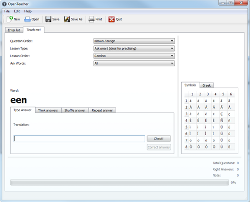This is my small top 7 of the most read articles from Linuxaria in the month of September, it’s your opportunity to read them if you missed them during last month.
7 – Pipes: what are they and Example of Use
Unix based operating systems like Linux offer a unique approach to join two commands on the terminal, with it you can take the output of the first command and use it as input of the second command, this is the concept of pipe or | . Pipes allow two separate process to communicate with each other also if they were not created to do it, so this open an infinite series of opportunity.
A basic example is:
ls -l | grep rwxrwxrwx |
This command will print the list of all the files in the local directory that have permission rwxrwxrwx (or that have rwxrwxrwx in their name).
6 – Guide to regular expressions with examples
The regular expression, or regexp, are the most powerful, versatile and hated tool used by programmers and system administrators.
They allow to express with a few characters search for strings, characters or words, and if done well can lead to good results, but if they are wrong they can not give you any useful result, and the worst thing is that often it is difficult to understand whether or not a regepx it is written with a correct syntax to cover all the possibility.
But now as first thing let’s see what is a regular expression:
From WIkipedia ”
In computing, a regular expression, also referred to as regex or regexp, provides a concise and flexible means for matching strings of text, such as particular characters, words, or patterns of characters. A regular expression is written in a formal language that can be interpreted by a regular expression processor, a program that either serves as a parser generator or examines text and identifies parts that match the provided specification.
”
5 – 3 easy steps to strengthen your ssh server
Back on ssh topic, i think this is third or perhaps the fourth article regarding ssh, one of my favorite tools on a Linux server, and that a lot of times is not used or configured properly. In this small guide i’ll show you some setup to make your ssh server a bit more safer from the most common attacks.
In particular i’ll show the configurations for openssh that is the most common and used ssh server in all Linux distributions but, as small suggestion, if you are using a VPS and you want to save some memory check also dropbear, it’s a valid alternative to openssh and it saves some space in your ram.
4 – Simple security by evaluating open ports
A simple but effective procedure for evaluating security on your computer is to check what sites it’s connecting to, or what sites are connecting to it. Most critical malware nowadays turn computers into zombies for botnets — typically zombified hosts will connect to a central server using IRC. Or it could be that you’re inadvertently running a program that’s listening for Internet requests. In any case, it’s good to check these connections.
3 – Tmux – the Terminal multiplexer
In a former article i’ve show how to use Screen and Byobu, in short Screen is a full-screen window manager that multiplexes a physical terminal between several processes (typically interactive shells) while Byobu is an elegant enhancement of the otherwise functional, plain, practical GNU Screen. Byobu includes an enhanced profile and configuration utilities for the GNU screen window manager, such as toggle-able system status notifications.
But today we’ll see something similar, but different: Tmux
2 – OpenTeacher – learn a new language with Linux

OpenTeacher is an opensource vocabulary training application that helps you learn a foreign language!
Enter a list of words in both a known and a foreign language, and OpenTeacher will test you, you can save your list and repeat the test over time.
OpenTeacher is an open source cross-platform application which works on Windows, Mac and Linux.
The release 2.2 has just been released and introduces some new features and support to external files.
1 – Understanding Nmap Commands: In depth Tutorial with examples
As we all know, Nmap (Network Mapper) is a stealth port scanner widely used by network security experts (including forensics & Pen-testing Experts). In this article we’ll see the different types of Nmap Scans, its techniques, understanding the purpose and goals of each scan , its advantages or disadvantages over other scanning tools, which could be better at evading firewalls & IDS (To a certain extent) and much more. In this first part, I have made my best to explain the basic scanning techniques, Host discovery options, port scanning options, techniques used in detecting Operating system & services running on the system.
i also give Nmap as already installed on your system.
Popular Posts:
- None Found
